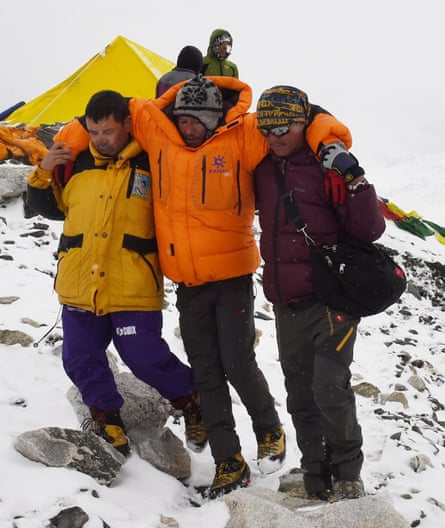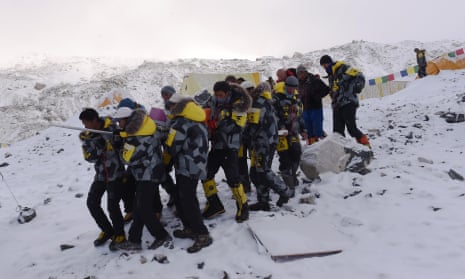Climbers trapped in Mount Everest’s higher camps by a devastating earthquake and avalanche have been battered by a powerful aftershock that sent fresh avalanches streaming around the base camps.
People on the mountain and in the base camps of nearby peaks said the tremor on Sunday morning shook the valley almost as strongly as Saturday’s initial quake.
Some 100 climbers are trapped at higher camps on the mountain, according to the Nepal Mountaineering Association. The latest earthquake – measured at 6.7 on the Richter scale – came as climbers at camps one and two were apparently trying to find a new route back through the Khumbu icefall, which is blocking their descent to the devastated base camp where at least 17 climbers died on Saturday and 61 more were injured.
The icefall – a maze of crevasses and ice cliffs – is usually equipped with fixed ropes so climbers can pass safely through it but the route was badly damaged during the first avalanche.
One of those trapped at camp one – the British-American climbing guide Dan Mazur, who has been sending updates from the ground – described avalanches on three sides of the camp and voiced concern for the climbers trying to reopen a safe route through the icefall.
Aftershock @ 1pm! Horrible here in camp 1. Avalanches on 3 sides. C1 a tiny island. We worry about icefall team below.. Alive?
— Daniel Mazur (@danielmazur) April 26, 2015
The aftershock came as the first helicopters braved poor weather to reach Everest base camp on Sunday morning to ferry 22 of the most badly injured to a clinic in the village of Pheriche. Others injured but able to walk made their way down to safety.
Meanwhile, more details have begun to trickle out from Everest and the neighbouring area about the scale of the tragedy. Everest ER – a non-profit group that runs an annual first aid station at the base camp – described the efforts to assist the many injured.
“Many of our friends in base camp have been seriously injured and killed,” the group wrote on its Facebook page. “With the help of nearly every able-bodied friend in base camp, we moved our clinic to the IMG camp where we are caring for patients. We [have] very limited communications at the moment. Pray for Nepal, friends. Namaste.”
The first photographs to emerge of the avalanche show the scale of the disaster. The Agence France-Presse photographer Roberto Schmidt captured a towering wall of snow and ice descending on base camp as well as the aftermath, when survivors frantically dug the dead and injured out of their ruined tents.

It appears that the avalanche destroyed at least 30 tents as well as parts of the route through the icefall leading to the higher camps.
According to witnesses, the source of Saturday’s slide was a series of peaks on the opposite side of the valley from Everest base camp – Pumori, Lintgren and Nuptse – with the most serious damage caused by the collapse of part of a band of ice cliffs – or seracs – on Lintgren.
Details of the situation on Everest remain scarce as communications were disrupted by the scale of the earthquake in Nepal, which was centred in the Kathmandu valley and has left more than 2,152 people dead, according to officials.
Before the aftershock, survivors contacted at Everest base camp via internet messaging services described a scene of terror as the snow and ice roared through the nearby Khumbu icefall and into their base.
The British Mountaineering Council’s website quoted climber Rolfe Oostra, who was at camp one when the first avalanche struck. He said: “As Jo and I arrived into C1 in low-vis we heard a tremendous noise, it was all around us – presuming an avalanche – which was a nightmare to pin the direction on. The noise and movement were enough to trip us off our feet.
“Later there was the loudest noise I have ever heard coming from below [base camp] which produced an enormous backdraft. It was not easy to work out what was going on but we were naturally now pretty wired trying to predict avalanches as well as make out what was happening.

“After frantic comms to BC it was related to us that there had been huge avalanches and landslides on a devastation scale into BC triggered by the earthquake. We are in radio comms with BC and sat phone comms back home. We are all okay but devastated for our friends and colleagues.”
Azim Afif, the 27-year-old leader of a climbing team from the University of Technology Malaysia, said his group was in a meal tent waiting for lunch when the table and everything around them began shaking.
When they ran outside, they saw “a wall of ice coming towards us” and heard the cries of Sherpa guides shouting for people to run for their lives, he said: “We just think to find a place to hide and save our life.”
The small team planned to sleep together in one large tent on Saturday night “to make sure if anything happens, we are together”, Afif said.
Google has reported that its employee Dan Fredinburg was among those who perished on the mountain. Paying tribute to the executive, who died of a head injury, Lawrence You, director of privacy, said: “Sadly, we lost one of our own in this tragedy. Dan Fredinburg, a long-time member of the privacy organisation … was in Nepal with three other Googlers, hiking Mount Everest. He has passed away.”
Gordon Janow, of the Washington-based guiding outfit Alpine Ascents International, said from Seattle that his team had come through the avalanche unscathed. Their first goal was to deal with the devastation at base camp, he said, and they would then try to create new routes to help climbers stuck above the treacherous Khumbu icefall.
“Everybody’s pretty much in rescue mode, but this is different from some independent climbing accident where people can be rescued and taken somewhere else,” Janow said. “I don’t know where somewhere else is.”
